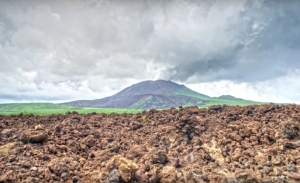
07 May ByTheBay VOYAGER – Northern Mariana Island Pagan
ByTheBay VOYAGER – Northern Mariana Island Pagan
Pagan is a volcanic island in the Mariana Islands archipelago in the Pacific Ocean, belonging to the Commonwealth of the Northern Mariana Islands. Formerly inhabited, the inhabitants were evacuated due to volcanic eruptions in 1981.
Archaeological finds indicate that Pagan was settled from several centuries BC. The first European contact was in 1669, when the island was sighted by the Spanish missionary Diego Luis de San Vitores who named it San Ignacio (Saint Ignatius in Spanish). It is likely that it was previously visited in 1522 by the Spanish sailor Gonzalo de Vigo, deserter from the Magellan expedition in 1521, and was the first European castaway in the history of the Pacific.[2] The native Chamorro population was forcibly deported to Saipan in 1695, and then three years later to Guam. The Chamorros began to return to Pagan in the early 19th century, but found that the island had been colonized by freed Kanakas from the Caroline islands. In the 1870s, first coconut plantations were established.
After the sale of the Northern Mariana islands by Spain to the German Empire in 1899, the island was administered as part of the colony ofGerman New Guinea and leased to a private company, the Pagan Society, which traded mainly copra. The company was a partnership between a German and a Japanese. The island was devastated by typhoons in July and September 1905, September 1907 and in December 1913 which destroyed the coconut plantations and bankrupted the Pagan Society. In 1914, during World War I, the island was captured by the Empire of Japan, which was awarded control by the League of Nations as part of the South Pacific Mandate. The island was settled by ethnic Japanese and Okinawans, who restored the coconut plantations and raised cotton and sweet potatoes for export. In addition, the Japanese developedcommercial fishing for bonito and tuna. On the island were ropes made and to a lesser extent sulfur removed. An airfield was established in 1935, and the Imperial Japanese Navy established a garrison in 1937. In 1942, the Japanese civilian population was 413 persons, with another 229 Chamorro residents. In June 1944, a garrison force of 2150 men of the Imperial Japanese Army arrived,[3] only to be cut off and isolated by the ongoing Allied offensive. Receiving supplies only occasionally by a submarine, the garrison soon faced starvation, and several hundred died of malnutrition before the surrender of Japan.

Landsat view of Pagan
After World War II, under United States occupation, Pagan became part of the UN Trust Territory of the Pacific Islands until the granting of U.S. Commonwealth status. After the war, the United States Navy maintained a small establishment on Pagan and during the 1950s built public institutions, including a church, a copra warehouse, infirmary and a school house. However, the civilian population was under 100 people by the end of the 1970s, many of whom were seasonally present from Saipan. On May 15, 1981, Mount Pagan erupted, with lava flows covering a large part of the island’s arable land and part of the runway. The eruption lasted until 1985; furthermore, small outbreaks came in 1987, 1988, 1992, 1993, 1996, 2006, 2009, 2010 and 2012. The population of the island was evacuated to Saipan in May 1981. Repeated petitions by the islanders to return have been rejected by the authorities due to the continuing threat posed by the volcano. Efforts are underway by the Northern Islands Mayor’s Office and concerned citizens to assist the approximately 300 displaced residents of the Northern Islands who wish to return and resettle in Anatahan, Alamagan, Pagan and Agrigan. Bandara was a settlement in the northwest of the island.
Pagan Island was included during Operation Christmas Drop 2006. United States Air Force C-130aircrew observed cattle and a small cluster of buildings, including a grass airstrip, located on the island. Plans by a Japanese investor group to use Pagan as a dumping ground for debris and rubble from the 2011 T?hoku earthquake and tsunami in Japan were provisionally shelved after protests in June 2012.[4]
Politically, Pagan remains part of the Northern Islands Municipality.


